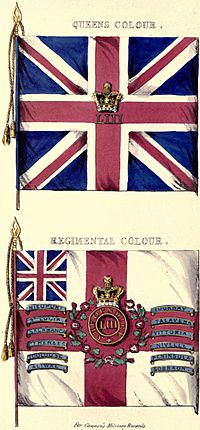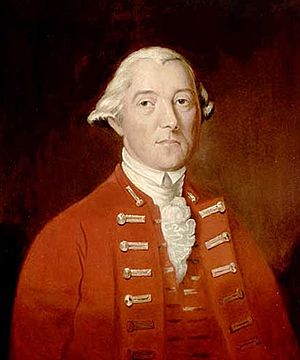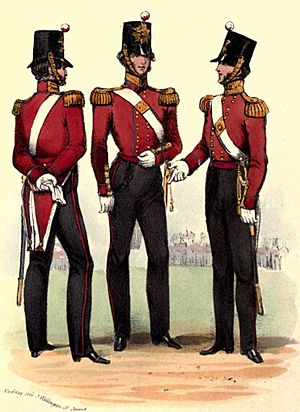53rd (Shropshire) Regiment of Foot facts for kids
Quick facts for kids 53rd Regiment of Foot |
|
|---|---|

Colours of the 53rd Regiment
|
|
| Active | 1755–1881 |
| Country | |
| Branch | |
| Type | Infantry |
| Size | One battalion (two battalions 1803–1817) |
| Garrison/HQ | Copthorne Barracks, Shrewsbury |
| Nickname(s) | "Old Five & Threepennies" "Brickdusts" "Red Regiment" |
| Colors | Red Facings |
| Engagements | American Revolutionary War French Revolutionary Wars Napoleonic Wars First Anglo-Sikh War Second Anglo-Sikh War Indian Rebellion |
| Commanders | |
| Notable commanders |
William Whitmore Sir John Abercromby |
The 53rd (Shropshire) Regiment of Foot was a famous British Army regiment (a group of soldiers) that started in 1755. It was known for its red uniforms. This regiment served in many important wars around the world.
In 1881, the 53rd Regiment joined with another group, the 85th (King's Light Infantry) Regiment of Foot. Together, they formed a new regiment called the King's Shropshire Light Infantry.
Contents
History of the 53rd Regiment
Early Days of the Regiment

The 53rd Regiment began in 1755 in Northern England. It was first called the 55th Regiment of Foot. Colonel William Whitmore created it to fight in the Seven Years' War.
In 1756, it was renamed the 53rd Regiment of Foot. This happened after two other regiments were closed down. The soldiers went to Gibraltar in 1756. After that, they returned home and moved to Ireland in 1768.
Fighting in the American Revolutionary War
In April 1776, the regiment left Ireland for North America. They arrived in Quebec City in May 1776. Their job was to help end the siege (a military blockade) of the city by American troops during the American Revolutionary War.
The 53rd Regiment fought under Sir Guy Carleton. They were at the Battle of Trois-Rivières in June 1776. They also fought in the Battle of Valcour Island in October 1776. Some of their best soldiers joined General John Burgoyne in the Saratoga campaign. This campaign did not go well for the British.
Other soldiers from the 53rd Regiment took part in raids. These included Carleton's Raid in 1778 and the Burning of the Valleys in 1780. In 1780, Lieutenant Richard Houghton led the Royalton raid. His troops burned three towns in eastern Vermont. In 1782, the regiment added "Shropshire" to its name. It became the 53rd (the Shropshire) Regiment of Foot. The regiment returned to England in 1789.
Battles in the Napoleonic Wars
In March 1793, the regiment went to Flanders to fight in the French Revolutionary Wars. They were involved in many battles and sieges. These included the Battle of Famars in May 1793 and the Siege of Valenciennes in June 1793. They also fought at the Siege of Dunkirk in August 1793.
The regiment also took part in the Siege of Nieuwpoort in October 1793. Later, they fought at the Siege of Landrecies in April 1794 and the Battle of Tournay in May 1794. The regiment returned to England in 1795.
Then, in November 1795, they sailed to the West Indies. There, they helped capture Saint Lucia in May 1796. They also helped stop a rebellion by Caribs on Saint Vincent in June 1796. They went on expeditions to Trinidad and Puerto Rico in 1797. The regiment came back home in 1802.

In 1803, a second group of soldiers, called the 2nd battalion, was formed. The 1st battalion went to India in April 1805. They went on a mission to the Fortress of Callinger in February 1812. They also fought in the Battle of Nalapani in October 1814 during the Anglo-Nepalese War. This was a difficult victory. The 1st battalion also fought against Pindari forces in 1817 during the Third Anglo-Maratha War. They did not return home until July 1823.
Meanwhile, the 2nd battalion went to Portugal in March 1809 for the Peninsular War. They fought in the Second Battle of Porto in May 1809 and the Battle of Talavera in July 1809. They then moved back to the Lines of Torres Vedras. They continued to fight in many battles. These included the Blockade of Almeida in April 1811 and the Battle of Fuentes de Oñoro in May 1811. They also fought at the Battle of Almaraz in May 1812 and the Battle of Salamanca in July 1812.
The 2nd battalion also took part in the Siege of Burgos in September 1812 and the Battle of Vitoria in June 1813. They then chased the French Army into France. They fought at the Battle of the Pyrenees in July 1813 and the Siege of San Sebastián in autumn 1813. Other battles included the Battle of Nivelle in November 1813 and the Battle of Toulouse in April 1814.
The 2nd battalion returned home in July 1814. In August 1815, this battalion went with Napoleon when he was sent away to the island of Saint Helena. They came back home in September 1817 and were officially closed down in October 1817.
The Victorian Era and Final Years
In July 1844, the regiment went back to India. They fought in the Battle of Aliwal in January 1846 and the Battle of Sobraon in February 1846 during the First Anglo-Sikh War. They also fought in the Battle of Gujrat in February 1849 during the Second Anglo-Sikh War.
The 53rd Regiment was also involved in the Indian Rebellion. They fought in the Siege of Cawnpore in June 1857. They helped relieve (rescue) Lucknow in November 1857 and capture it in spring 1858. Five soldiers from the regiment earned the Victoria Cross for their bravery during this rebellion.
The regiment returned to England in 1860. For the next four years, they were stationed in different places like Aldershot and Plymouth. In 1864, they moved to Curragh Camp in Ireland. Because of threats from the Fenian Brotherhood in the United States, the regiment left Ireland for Canada. They arrived in Quebec in August 1866. They were stationed in London for two years. In 1868, they moved to the Quebec Citadel. Finally, in 1870, they left Canada for Barbados.
In the 1870s, the British Army made changes called the Cardwell Reforms. These changes linked regiments together. The 53rd Regiment was linked with the 43rd (Monmouthshire) Regiment of Foot. They shared a training base in Shrewsbury. On July 1, 1881, new changes called the Childers Reforms came into effect. The 53rd Regiment joined with the 85th Regiment of Foot (Bucks Volunteers) to become the King's Shropshire Light Infantry.
Battle Honours of the Regiment
Battle honours are special awards given to regiments for their bravery in battles. Here are some of the honours earned by the 53rd Regiment:
- Nieuport 1793 Flanders Campaign
- Tournay 1794 Flanders Campaign
- St Lucia 1796 West Indies
- Talavera 1809 (2nd Battn.) Peninsular War
- Salamanca 1812 (2nd Battn.) Peninsular War
- Vittoria 1813 (2nd Battn.) Peninsular War
- Pyrenees 1813 (2nd Battn.) Peninsular War
- Nivelle 1813 (2nd Battn.) Peninsular War
- Toulouse 1814 (2nd Battn.) Peninsular War
- Peninsula 1809–1814 (2nd Battn.) Peninsular War
- Aliwal 1846 1st Sikh War (Sutlej campaign)
- Sobraon 1846 1st Sikh War (Sutlej campaign)
- Goojerat 1849 2nd Sikh War (Punjab Campaign)
- Punjab 1848–49
- Lucknow 1857–58 Indian Mutiny
Victoria Cross Heroes
The Victoria Cross is the highest award for bravery in the British military. These brave soldiers from the 53rd Regiment earned the Victoria Cross during the Indian Mutiny:
- Corporal Denis Dynon (October 2, 1857)
- Lieutenant Alfred Kirke Ffrench (November 16, 1857)
- Private Charles Irwin (November 16, 1857)
- Private James Kenny (November 16, 1857)
- Sergeant Major Charles Pye (November 17, 1857)


